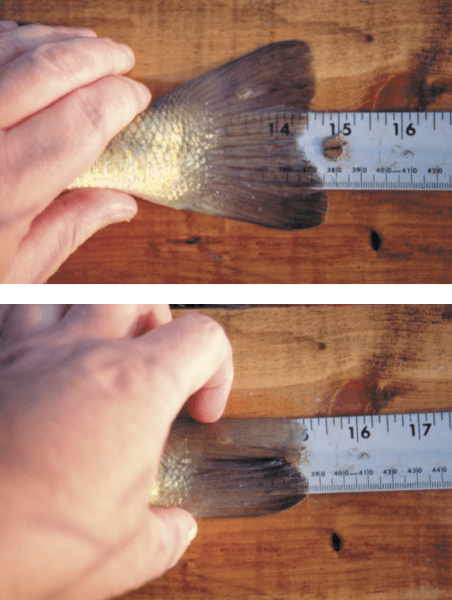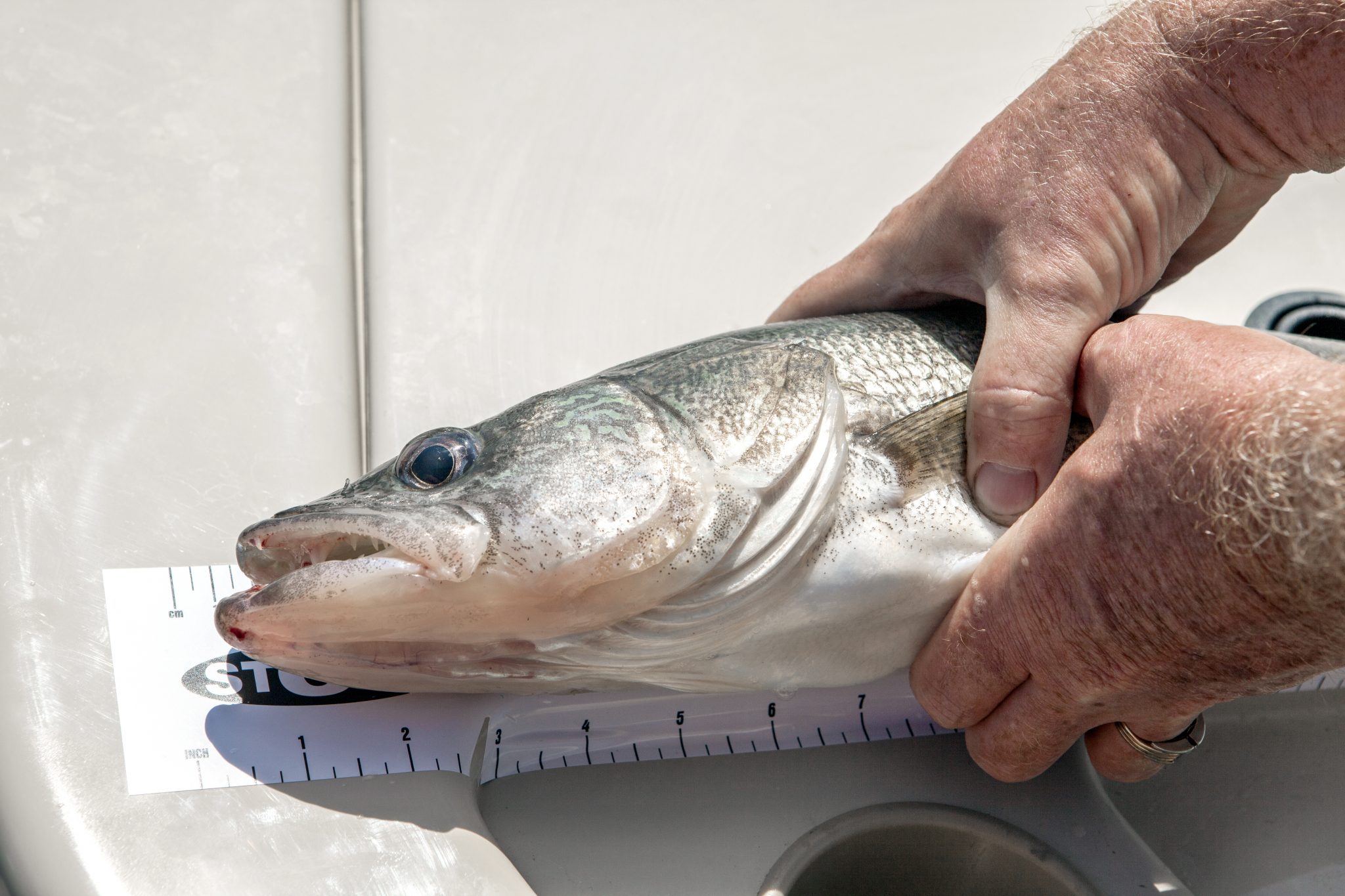Fish & Water

Fisheries biologists use many different tools and techniques to determine the proper management of fish populations in our lakes, streams, and ponds. Some of these techniques are fairly simple and can be used by pond owners to help manage their own populations of largemouth bass and bream.

Incorrect (top) and correct (bottom) ways to properly measure a fish.
Fisheries managers often need to know if fish are growing poorly or even losing weight. Lack of food, poor water quality, poor water temperatures (too hot or too cold), or disease can cause stress that results in poor growth. While growth may be difficult to measure, condition or plumpness of the fish is easy to measure and indicates if the fish are under stress.
Using Relative Weight
One measure of the condition of a fish is its relative weight. Relative weight is the ratio of the actual weight of a fish to what a rapidly growing healthy fish of the same length should weigh, called standard weight. Fish with high relative weights are fat while those with low relative weights are thin. Of course, ponds should be managed to produce healthy, fast-growing fish.
To calculate the relative weight for a fish, one simply divides the weight of the fish in pounds by the standard weight for a fish of the same length. Standard weights can be found in Table 1 for largemouth bass, bluegill, and redear sunfish (also called shellcrackers). Fish should be measured from the tip of the nose with the mouth closed to the end of the tail. Scales for weighing fish can be purchased at most sporting goods stores. Fish that have a relative weight less than 0.80 or 80 percent of the standard are considered severely thin, indicating a lack of food for that animal. Relative weights between .8 and 1, while not ideal, are well within the range found in healthy populations.
Bass Relative Weight
| High | Low | |
|---|---|---|
| Low (bream relative weight) | Bream crowded. Competing forage (shad, shiners, bullheads). | Poor fertility. Inconsistent management. Competing species (crappie, catfish, common carp). Excess weeds. |
| High (bream relative weight) | Pond is well managed | Bass crowded. Competing predators (large catfish, striper, hybrids, etc.). Hybrid bream present.. |
Calculating Relative Weight
Suppose you caught a largemouth bass that was 15 inches long and weighed 1.5 lbs. What would be the relative weight of that bass?
- Look up the standard weight of a 15-inch largemouth bass from Table 1. Standard weight for a 15” bass = 1.8 lbs.
- Divide the weight of your fish by standard weight. Relative weight = 1.5 / 1.8 = 0.83. This bass weighs 83 percent of the standard weight of a bass the same length.
Pond owners can use the relative weight of the fish they catch from the pond to keep track of the success of their pond-management strategies. Owners should measure the relative weight of bass and sunfish for as many sizes as possible throughout the season. Relative weight can change throughout the season, so individual fish may be thin or fat at different times. By measuring relative weight for many fish over the course of the year, the pond owner should be able to see the overall condition of fish in the population.
If a pond is in balance (containing the proper number and sizes of bass and bream to produce good growth and fishing), there should be adequate food for all sizes of both bass and bream. In balanced ponds, the relative weights for most fish will be greater than 0.9. Low relative weight due to lack of food can be caused by poor fertility, excess weeds, competing undesirable fish (for example crappie, golden shiners, gizzard shad, or bullheads) or too many bass or bream in a pond. Sudden changes in management, such as inconsistent fertilization, can result in poor fish condition. In ponds with too many bass (bass-crowded ponds), the bass will have low relative weights with bass between 10 and 14 inches typically being very thin. In bass-crowded ponds, there is simply not enough small-to medium-sized bream to feed all those hungry bass. Adult bluegill in these bass-crowded ponds will usually be in excellent shape with high relative weight. Since few bluegill survive the intense predation by bass to become large adults, there is little competition for food among bluegills. In ponds with too many bluegills (bluegill crowded), the bass will usually have high relative weight with bluegill in poor condition. Ponds with competing species, poor fertility, or overabundant weeds will generally produce bass and bream with low relative weight. Hybrid bluegill (bluegill X green sunfish) create a special problem. Because they are not completely sterile, these hybrids can mate with bluegill. The resulting fish typically produces so few young that there simply is not enough food produced to support the bass population.
Records of relative weight and harvest can be provided to fisheries biologists or Extension personnel when these professionals check ponds to help diagnose management problems. While relative weight by itself cannot provide full diagnoses of problems in ponds, it does give the pond owner an ongoing measure of the vitality of the fish and an early warning of potential management problems.
Find Alabama Extension’s Relative Weight Calculator at https://www.aces.edu/blog/topics/fisheries/fish-relative-weight-calculator/.
Table 1. Standard Weight for Largemouth Bass, Bluegill, and Redear Sunfish (Shellcrackers)
| Largemouth Bass | Bluegill | Redear Sunfish (shellcrackers) | |||
|---|---|---|---|---|---|
| Length (inches) | Standard Weight (lb.) | Length (inches) | Standard Weight (lb.) | Length (inches) | Standard Weight (lb.) |
| 10 | 0.5 | 6 | 0.2 | 6 | 0.1 |
| 10.5 | 0.6 | 6.5 | 0.2 | 6.5 | 0.2 |
| 11 | 0.7 | 7 | 0.2 | 7 | 0.3 |
| 11.5 | 0.8 | 7.5 | 0.3 | 7.5 | 0.3 |
| 12 | 0.9 | 8 | 0.4 | 8 | 0.4 |
| 12.5 | 1 | 8.5 | 0.4 | 8.5 | 0.5 |
| 13 | 1.1 | 9 | 0.6 | 9 | 0.5 |
| 13.5 | 1.3 | 9.5 | 0.7 | 9.5 | 0.6 |
| 14 | 1.5 | 10 | 0.9 | 10 | 0.7 |
| 14.5 | 1.6 | 10.5 | 1 | 10.5 | 0.8 |
| 15 | 1.8 | 11 | 1.2 | 11 | 1 |
| 15.5 | 2 | 11.5 | 1.4 | 11.5 | 1.1 |
| 16 | 2.2 | 12 | 1.6 | 12 | 1.3 |
| 16.5 | 2.5 | 12.5 | 1.8 | 12.5 | 1.4 |
| 17 | 2.7 | 13 | 2.1 | 13 | 1.6 |
| 17.5 | 3 | 13.5 | 2.4 | 13.5 | 1.8 |
| 18 | 3.2 | 14 | 2.7 | 14 | 2.1 |
| 18.5 | 3.5 | 14.5 | 3 | 14.5 | 2.3 |
| 19 | 3.9 | 15 | 3.4 | 15 | 2.5 |
| 19.5 | 4.2 | ||||
| 20 | 4.5 | ||||
| 20.5 | 4.9 | ||||
| 21 | 5.3 | ||||
| 21.5 | 5.7 | ||||
| 22 | 6.2 | ||||
| 22.5 | 6.6 | ||||
| 23 | 7.1 | ||||
| 23.5 | 7.6 | ||||
| 24 | 8.1 | ||||
| 24.5 | 8.7 | ||||
| 25 | 9.3 | ||||
| 25.5 | 9.9 |
Russell Wright, Extension Specialist, Associate Professor, Fisheries, Aquaculture, and Aquatic Sciences, Auburn University
Reviewed October 2022, Relative Weight: An Easy-to-Measure Index of Fish Condition, ANR-1193

